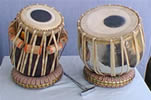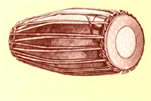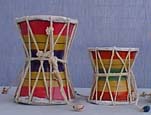|
PERCUSSION INSTRUMENTS
1. Tabla
 Tabla falls under the category of avanad
vad (percussion instruments). It is an ancient indigenous tal vad. Tabla falls under the category of avanad
vad (percussion instruments). It is an ancient indigenous tal vad.
It consists of two drums standing upright. Bharata mentions the procedure of
applying the
paste on the drum. However it became popular during the Moghul rule because it was, and even
today
is regarded as a fit accompaniments for khayal and
thumri compositions.
The drum with the black paste called siyahi, played by the right hand, is the real
tabla, because its tone-range is
roughly
and octave. The drum played with the left and is the bass or the drone counterpart and is
called
dugga or duggi or bayan. Tabla requires a lot of practice for
reproducing
different tals, especially half hatras. According to Danielou, “The drummer of our
Indian
village is in no way technically inferior to the most celebrated concert musicians.”[3]
Allah
Rakha and Samta Prasad are two well-known tabla players who have delighted both Indian and
Western
audiences.
TUNNING THE TABLA
A Tabla-player keeps the two drums in front of him, the real tabla on his
right
and the duggi on his left. The right drum is tuned to S or P. In the raga in
which
P is omitted, it is tuned to M. A small hammer is used for tuning, the cylindrical
wood-pieces under
the straps. If the tabla is to be tuned down, the gitki (wood-piece) is pushed up.
After
hammering on one gitki, the next one to be set is on the opposite side. In this
manner, all
the gitkies are hammered and while hammering them, the tabla is struck
with the
hand to find out if the svara of the tabla matches with the base note of
the
instrument which the musician is using. After the gitkies are set up, the
gajra (top-skin)
is adjusted in case there is still some minor tone variation. The duggi or the left
tabala is
adjusted with the gajra. In some sets of tabala, the duggi has
also
some gitkies which are adjusted in the same manner as those of the right drum. In
case
there is no black paste (siyahi) on the duggi, it should be covered with
atta
(wheat-dough). The dough should be removed or gently scratched after use. The right
tabla can
prodice a variety of complicated rhythms, while the duggi can produce a variety of
complicated rhythms, while the duggi can only produce the main outline of the
particular
tal (rhythm). An expert tabla player (tablachi) can even play half matras
skillfully.
2. Mridanga/Pakhawaj
 The mridanga is an ancient
instrument
of avanad vad and is also called tal vad. It is said that Lord Shiva used
to do
Tandava Nirtya-cosmic dance with the help of this instrument. Bharata calls it
pushkar
vad. This word was adapted as Pakhawaj. As such, mridanga and
pakhawaj are
practically the same. The mridanga is an ancient
instrument
of avanad vad and is also called tal vad. It is said that Lord Shiva used
to do
Tandava Nirtya-cosmic dance with the help of this instrument. Bharata calls it
pushkar
vad. This word was adapted as Pakhawaj. As such, mridanga and
pakhawaj are
practically the same.
Pakhawaj was, and even today is, popular as an accompaniment of dhrupad and
dhamar. The
mridanga was formerly a clay-drum but now it is made of wood. The structure of the
pakhawaj resembles
that of the tabla, the main difference being that the tabla consists of two drums,
while
the pakhawaj is one long barrel-like drum with skin-covers on both unequal sides.
The left
side is smaller than the right side. The pakhawaj is tuned like the
tabla. There
are two ways of playing the mridanga. It can play twenty-five varanas, both
primary and secondary as follows:
Primary varnas: Ta, Ta, Di, Thu, Na, Dha, Dda, Draday,
Thee, Ga, Rivrar, Jhem.
Secondary varnas: Ran, Ka, Ga, Rran, Dhou, Dhi, Lan,
Thace, Dan, Dhi, Ki, Ti, Thrar.
3. Dholak
 The other popular drum
instrument is
called dholak or dhavul. It is like the mridanga, but its two
sides are
equal in size. It is about two feet long and one foot in diameter. It can be played with
hands or
with sticks. It is used for hymn-singing, folk music and folk-dance. The left side is like
bass and
other side can be tuned to a high pitch by tightening the cotton-rope braces. The other
drum-type
instrument are nagara, tasha, kajira, and damru. The other popular drum
instrument is
called dholak or dhavul. It is like the mridanga, but its two
sides are
equal in size. It is about two feet long and one foot in diameter. It can be played with
hands or
with sticks. It is used for hymn-singing, folk music and folk-dance. The left side is like
bass and
other side can be tuned to a high pitch by tightening the cotton-rope braces. The other
drum-type
instrument are nagara, tasha, kajira, and damru.
4. Dhadh
 It is small two-sided wooden
drum. Some
call it the damru. It is about 10 to 12 inches in length with a narrow waist in the
middle.
The parchments are held by cotton straps. It is held in the left hand and played with the
right
hand. It is small two-sided wooden
drum. Some
call it the damru. It is about 10 to 12 inches in length with a narrow waist in the
middle.
The parchments are held by cotton straps. It is held in the left hand and played with the
right
hand.
|
